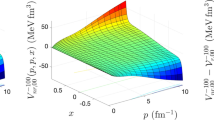Abstract
The integral equations approach to the three-nucleon problem is reviewed. The results of different calculations with local potentials are compared.
Резюме
Рассматриваются интегральные уравнения, связанные с проблемой трех ядер. Сравниваются результаты различных вычислений с помощью локальных потеницалов.
Similar content being viewed by others
References
The basic definitions of multichannel scattering theory are given in several textbooks. Original papers are:H. Ekstein, Phys. Rev.,101, 880, 1956 and further references cited inT. F. Jordan, J. Math. Phys.,3, 429, 1962. See alsoW. Brenig andR. Haag, Fortschr. Physik7, 183, 1959 and the bibliography given in [3].
L. D. Faddeev, Zh. Eksperim. i Teor. Fiz.,39, 1459, 1960 [English transl.: Soviet Phys. — JETP,12, 1014, 1961]; Dokl. Akad. Nauk SSR,138, 565, 1961 [English transl.: Soviet Phys. — Doklady,6, 384, 1961]; Dokl. Akad. Nauk SSR145, 301, 1962, [English transl.: Soviet Phys. — Doklady,7, 600, 1963]. For early attempts see [6] andG. V. Skornjakov andK. A. Ter-Martirosjan, JETP,31, 775, 1956.
L. D. Faddeev, Mathematical aspects of the three-body problem in the quantum scattering theory, Publications of the Steklov Mathematical Institute (Leningrad, 1963) No. 69; [English transl.: Israel Program for Scientific Translation, Jerusalem, 1965, distributed by Oldbourne Press, London].
The specialFaddeev-type equations (3.1) were introduced in [5]. They are best suited for the quasiparticle method developed there and described in Section 6 of this talk. (Compare also the equations given in [9] and [10]).
E. O. Alt, P. Grassberger andW. Sandhas, Nucl. Phys.,B2, 167, 1967.
K. M. Watson, Phys. Rev.,89, 575, 1953. Compare alsoK. M. Watson andJ. Nuttall, Topics in Several Particle Dynamics, Holden-Day, San Francisco, 1967.
R. J. Glauber, in: High Energy Physics and Nuclear Structure, ed.: G. Alexander (North Holland, Amsterdam, 1967).
A. Ahmadzadeh andJ. A. Tjon, Phys. Rev.,139, B1085, 1965.
C. Lovelace, in: Strong Interactions and High Energy Physics, ed.: R. G. Moorhouse (Oliver and Boyd, London, 1964).
C. Lovelace, Phys. Rev.,135, B1225, 1964.
Y. Yamaguchi, Phys. Rev.,95, 1628, 1954 and further references given in footnote 28 of [10]. Note the difference in the definition of the form factors χγ introduced in Eq. (5.2) and in the preceding section.
A. N. Mitra, Nucl. Phys.,32, 529, 1962; Phys. Rev.,139, B1472, 1965.A. N. Mitra andV. S. Bhasin, Phys. Rev.,131, 1265, 1963.A. N. Mitra, in Advances in Nuclear Physics, ed.: M. Baranger and E. Vogt (Plenum Press, Inc., New York, 1969), Vol. III.
A. G. Sitenko andV. F. Kharchenko, Nucl. Phys.,49, 15, 1963.
R. D. Amado, Phys. Rev.,132, 485, 1963;141, 902, 1966. See also [35] andR. D. Amado, Annual Review of Nuclear Science,19, 635, 1969.
S. Weinberg, Phys. Rev.,131, 440, 1963.
See, e. g., [9], [10], [15], andK. Meetz, J. Math. Phys.,3, 690, 1962.
Compare alsoJ. H. Sloan, Phys. Rev.,165, 1587, 1968;M. G. Fuda, Phys. Rev.,166, 1064, 1968;F. Riordan, Nuovo Cimento,54, A552, 1968;L. Rosenberg, Phys. Rev.,168, 1756, 1968;R. Yaes, Phys. Rev.,170, 1236, 1968.
As shown in [25], Appendix C, expression (6.3) can be transformed into a simpler form which is also found directly by application of the quasiparticle concept to the three-body Lippmann — Schwinger equation. (P. Grassberger andW. Sandhas, Z. Physik,217, 9, 1968).
J. Carew andL. Rosenberg, Phys. Rev.,177, 2599, 1969.E. O. Alt, P. Grassberger andW. Sandhas, to be published.
J. W. Humberston, R. L. Hall andT. A. Osborn, Phys. Lett.,27B, 195, 1968.
R. A. Malfliet andJ. A. Tjon, Nucl. Phys.,A127, 161, 1969.
Y. E. Kim, J. Math. Phys.,10, 1491, 1969; Phys. Lett.,29B, 411, 1969.
J. S. Ball andD. Y. Wong, Phys. Rev.,169, 1362, 1968.
I also mention similar calculations byB. Akhmadkhodzhaev, V. B. Belyaev andE. Wrzencionko, JETP Lett.,9, 433, 1969.
E. O. Alt, P. Grassberger andW. Sandhas, Phys. Rev.,D1, 2581, 1970.
E. O. Alt, P. Grassberger andW. Sandhas, Nuovo Cimento, (in press).
J. A. Tjon, Phys. Rev.,D1, 2109, 1970.
E. O. Alt, P. Grassberger andW. Sandhas, loc. cit. (Ref. 19). Note that the 1. QBA in Fig. 10 is taken from this reference where the corresponding results of Ref. 25 are improved by optimizing the form factors.
V. F. Kharchenko andN. M. Petrov, Nucl. Phys.,A137, 417, 1969;V. F. Kharchenko andS. A. Storozhenko, Nucl. Phys.,A137, 437, 1969.
M. Fuda, Phys. Rev.,178, 1682, 1969.
The situation till 1969 has been reviewed byL. M. Delves andA. C. Phillips, Revs. Mod. Phys.,41, 497, 1969.
D. Hurst andJ. Alcock, Can. J. Phys.,29, 36, 1951.
W. T. H. van Oers andJ. D. Seagrave, Phys. Lett.,24B, 562, 1967.
V. S. Bhasin, G. L. Schrenk andA. N. Mitra, Phys. Rev.,137, B398, 1965.
R. Aaron, R. D. Amado andY. Y. Yam, Phys. Rev.,140, B1291, 1965.
A. C. Phillips, Phys. Rev.,142, 984, 1966.
E. O. Alt andW. Sandhas, to be published.
This is discussed by other speakers at this conference.
R. A. Malfliet andJ. A. Tjon, Phys. Lett.,30B, 293, 1969; Ann. Phys. (N. Y.)61, 425, 1970. I also refer toMalfliet’s talk at this conference.
Calculations with other more complicated local potentials have also been performed byY. E. Kim andA. Tubis, Phys. Rev.,C1, 1627, 1970.V. B. Belyaev, E. Wrzecionko andA. L. Zubarev, Yadern, Fiz.,12, 923, 1970.
This picture is taken from [35] with the 1. QBA result from [37] drawn in.
Author information
Authors and Affiliations
Rights and permissions
About this article
Cite this article
Sandhas, W. Three-nucleon calculations with local potentials. Acta Physica 33, 109–127 (1973). https://doi.org/10.1007/BF03158000
Issue Date:
DOI: https://doi.org/10.1007/BF03158000



